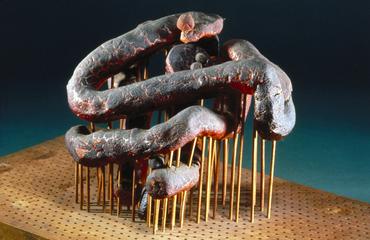
Marsh's arsenic apparatus on wooden stand
Marsh's arsenic apparatus on wooden stand
In this test, described by James Marsh (c. 1790-1846) of Woolwich Arsenal, any arsenic in a sample is reduced to arsine which decomposes on burning into hydrogen and arsenic.
The acidified sample is poured in through the longer arm, until the shorter arm is nearly filled, when it reacts with a piece of metallic zinc in the tube.
Arsenic can be detected by holding a piece of glass over the flame as the resulting gas is burnt.
If no arsenic is present, only hydrogen is evolved which quickly heats the glass plate and may even shatter it. The test is capable of detecting one part in 200 million and was used in forensic work.




